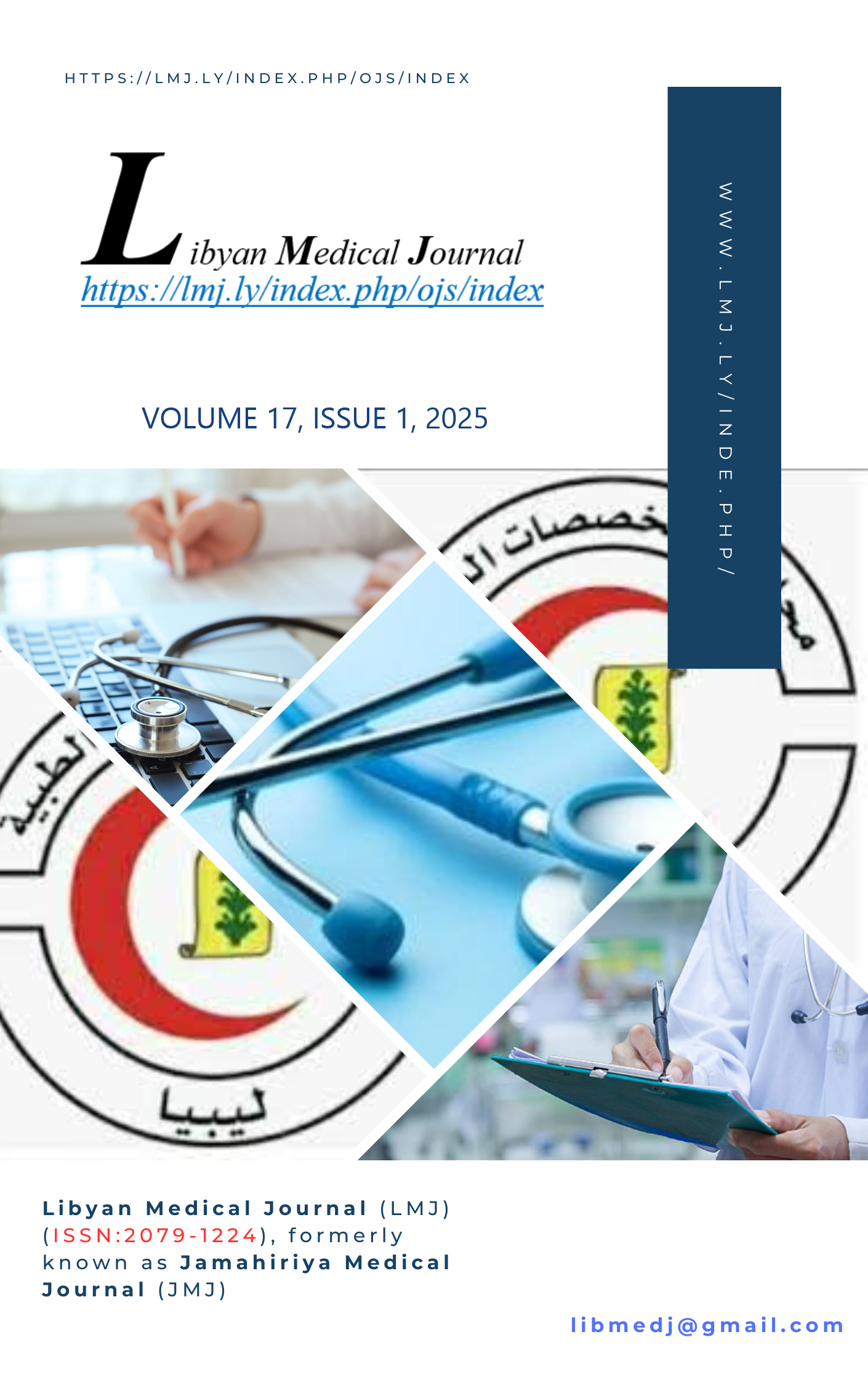Prevalence of Helicobacter Pylori Infection in Relation to Gender and Age in the Population of AL-Ajailat, Libya
DOI:
https://doi.org/10.69667/lmj.2517109Keywords:
Helicobacter Pylori, Prevalence, SeroprevalanceAbstract
Helicobacter pylori are bacteria that can lead to an infection in the stomach or duodenum, which is the first segment of the small intestine. They are the most prevalent cause of peptic ulcer disease. If left untreated, a long-term H. pylori infection can result in complications. This study was performed to determine the prevalence of Helicobacter pylori infection and its relation to age and gender in a population of AL-Ajailat, Libya. Methods. The study was a retrospective cross-sectional study conducted in the central AL-jailat clinic (Laboratory Department) from January 2023 to July 2023 to determine seroprevalence of H. pylori infection. A total of 413 participants (127 males and 255 females, aged between 1 and 89 years) were included in this study. For the detection of H. pylori, enzyme-linked immunosorbent assay kits were utilized. In contrast, the absence of both antibodies (IgG and IgM) resulted in the designation of H. pylori-negative status. Anti-H. pylori immunoglobulin (Ig)G/IgM>22 IU/L were classified as H. pylori positive. The analysis was performed by using the statistical package for the social sciences, SPSS version 27. Result. A total of 413 subjects were enrolled in this study. The overall prevalence of H. pylori infection was 84.7%. H. pylori infection prevalence was higher in females than in men (70.3% vs. 29.7%, p = 0.001), respectively. The highest prevalence of H. pylori infection is observed in the age groups of 40-49 years (21.4%) and 30-39 years (18.9%), compared with the other age groups, but a p-value of 0.256 suggests that there is no statistically significant association between age and H. pylori infection status. Conclusion. Prevalence of H. pylori infection was high in this study. H. pylori infection seroprevalence was higher in females than males and middle-aged people are more vulnerable to H. pylori infection
البكتيريا الملوية البوابية هي بكتيريا يمكن أن تؤدي إلى إصابة المعدة أو الاثني عشر، وهو أول جزء من الأمعاء الدقيقة. وهي السبب الأكثر انتشارًا لمرض قرحة المعدة. إذا تُركت دون علاج، يمكن أن تؤدي عدوى البكتيريا الملوية البوابية طويلة الأمد إلى مضاعفات. أجريت هذه الدراسة لتحديد انتشار عدوى البكتيريا الملوية البوابية وعلاقتها بالعمر والجنس في مجموعة سكانية من العجيلات، ليبيا. الطرق. كانت الدراسة دراسة مقطعية استرجاعية أجريت في عيادة العجيلات المركزية (قسم المختبرات) من يناير 2023 إلى يوليو 2023 لتحديد معدل انتشار عدوى البكتيريا الملوية البوابية. تم تضمين ما مجموعه 413 مشاركًا (127 ذكرًا و 255 أنثى، تتراوح أعمارهم بين 1 و 89 عامًا) في هذه الدراسة. للكشف عن البكتيريا الملوية البوابية، تم استخدام مجموعات اختبار الممتز المناعي المرتبط بالإنزيم. وعلى النقيض من ذلك، أدى غياب كل من الأجسام المضادة IgG و IgM إلى تحديد حالة سلبية لـ البكتيريا الملوية البوابي. تم تصنيف الغلوبولين المناعي المضاد للبكتيريا الملوية البوابية IgG/IgM>22 IU/L على أنه إيجابي للبكتيريا الملوية البوابية. تم إجراء التحليل باستخدام الحزمة الإحصائية للعلوم الاجتماعية، الإصدار 27 من برنامج SPSS. النتيجة. تم تسجيل ما مجموعه 413 مشاركا في هذه الدراسة. بلغ معدل الانتشار العام لعدوى البكتيريا الملوية البوابية 84.7٪ . كان معدل انتشار عدوى البكتيريا الملوية البوابية أعلى لدى الإناث منه لدى الرجال (70.3٪ مقابل 29.7٪، p = 0.001)، على التوالي. لوحظ أعلى معدل انتشار لعدوى الجرثومة الملوية البوابية في الفئات العمرية 40-49 سنة (21.4٪) و 30-39 سنة (18.9٪)، مقارنة بالفئات العمرية الأخرى، ولكن قيمة p البالغة 0.256 تشير إلى عدم وجود ارتباط ذي دلالة إحصائية بين العمر وحالة الإصابة بالجرثومة الملوية البوابية. الاستنتاج. كان معدل انتشار عدوى الجرثومة الملوية البوابية مرتفعًا في هذه الدراسة. كان معدل انتشار عدوى الجرثومة الملوية البوابية أعلى لدى الإناث منه لدى الذكور، والأشخاص في منتصف العمر أكثر عرضة للإصابة بعدوى الجرثومة الملوية البوابية
References
Sharndama HC, Mba IE."Helicobacter pylori: an up-to-date overview on the virulence and pathogenesis mechanisms". Braz J Microbiol2022;53(1)33-50.
Atia A, Abuagela M, Abdulwahed E, Jerbi R, Alwaseea N, Ahmed F, Alaqeli E, Ashur AB, El Magrahi H, Mousa A. Seroprevalence of Helicobacter pylori Infection in Tripoli, Libya. Mustansiriya Medical Journal. 2023 Jan 1;22(1):68-70.
Eshraghian A. Epidemiology of Helicobacter pylori infection among the healthy population in Iran and countries of the Eastern Mediterranean region: systemic review of prevalence and risk factors. World J Gastroenterol.2014;20:17618-25.
Mahdawi N, Karim I, Abdulazez Z, ALmsagrei N, Alaswad N. Study of Correlation between H. pylori, Life Habits, and Risk Factors among Adult Patients in Gharyan, Libya. AlQalam Journal of Medical and Applied Sciences. 2024 Nov 4:1141-5.
Ernst, P.B. & Gold, B.D. 2000. The disease spectrum of Helicobacter pylori: The immunopathogenesis of gastroduodenal ulcer and gastric cancer. Annu. Rev. Microbiol. 54: 615-640.
Khalleefah M, Hasen Y, Elfituri Z, Edeeb M, Alreeshi K. Prevalence of H. pylori Infection among Patients with Chronic Gastric Symptoms and The Role of Gastric Biopsy in its Diagnosis and Management. AlQalam Journal of Medical and Applied Sciences. 2023 Dec 10:788-93.
Ahmad A, Govil Frank BB. Gastric mucosa-associated lymphoid tissue lymphoma. Am J Gastroenterol 2003;98: 975-86.
Chen J, Bu XL, Wang QY, Hu PJ, Chen MH. Decreasing seroprevalence of Helicobacter pylori infection during1993-2003 in Guangzhou, southern China. Helicobacter 2007; 12: 164-169.
Payão SL, Rasmussen LT. Helicobacter pylori and its reservoirs: A correlation with the gastric infection. World J Gastrointest Pharmacol Ther 2016; 7:126-32.
Mégraud Epidemiology of helicobacter pylori infection. Gastroenterol.Clin. North Am.1993; 22:73-88.
Andersen LP, Rosenstock SJ, Bonnevie O, et al. Seroprevalance of immunoglobinG, M and an antibody to Helicobacter pylori in an unselected Danish population. Am J Epidemiol1996; 143:1157-64.
Mohammad M, ALtayar M, Toboli A, Bakka A. Characteristics of Helicobacter pylori infection in Libyan healthy peoples in two teaching hospitals in Benghazi. Med J Islamic World Acad Sci2011; 19:27-32.
Pajavand H, Alvandi A, Mohajeri P, Bakhtyari S, Bashiri H, Kalali BM et al. High Frequency of vac A s1m2 Genotype Among Helicobacter pylori Isolates from Patient with Gastroduodenal Disorders in Kermanshah. Jundishapur J Microbiol.2015;8(11) dio:10.5812/jjm.25425.
Ahmed SM, Hussein A, Ali E, Meeky WM, Abdel-Fattah HM, et al. The prevalence of Cag-A and Vac-A Genotypes among Helicobacter pylori Infected Egyptian Patients. The ASM.114th General Meeting of the American Society for Microbiology; Boston: USA.2014.
Nguyen TM Ramsey D, Grham D, Shaib Y, Shiota S, Velez M, et al. The prevalence of Helicobacter pylori Remains High in African American and Hispanic Veterans. Helicobacter.2015;20(4):305-11.
Kadi R, Halawani E, Abdelkader H. Prevalence of H. pylori strains harboring cag A and ice A virulence gene in Saudi patients with gastritis and peptic ulcer disease. Microbiology discovery.2014.
Hong W, Dong L, Stock S, Basharat Z, Zippi M, Zhou M. Prevalence and characteristics of colonic adenoma in mainland China. Cancer Manag Res 2018; 10: 2743-2755
Hong W, Geng W, Wang C, Dong L, Pan S, Yang X, Zippi M, Xu C, Zhou M, Pan J. Prevalence of colonic diverticulosis in mainland China from 2004 to 2014. Sci Rep 2016; 6: 26237.
Chen J, Bu XL, Wang QY, Hu PJ, Chen MH. Decreasing seroprevalence of Helicobacter pylori infection during1993-2003 in Guangzhou, southern China. Helicobacter 2007; 12: 164-169.
Aguemon BD, Struelens MJ, Massougbodji A, Ouendo EM. Prevalence and risk-factors for Helicobacter pylori infection in urban and rural Beninese populations. Clin Microbiol Infect 2005; 11: 611-617.
Bakk AS, Salih BA. Prevalence of Helicobacter pylori infection in asymptomatic subjects in Libya. Diagnostic microbiology and infectious disease2002;43(4):265-8.
Altyar I, Abdalla A, Abdalwahab S. The seroprevalence of Helicobacter pylori infection in Tripoli(Libya). Nature and Science.2015;13:81-6.
Alemayehu A. Seroprevalence of Helicobacter pylori infection and its risk factors among adult patients with dyspepsia in Hawassa teaching and referral hospital, south Ethiopia. Addis Ababa university, Ethiopia.2011.











